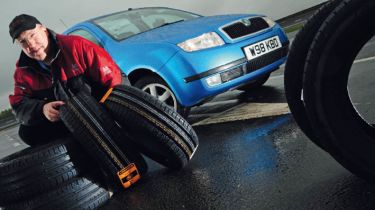So why do tyres need Best Before dates?
An Auto Express investigation revealed that tyres can ‘go off’, just like a carton of eggs or a bottle of milk. And when we hit the test tracks to find out how much difference age made, we discovered a shocking gap in performance between old and new rubber.

- Old tyres increase a car’s stopping distance by 23 per cent, an exclusive Auto Express investigation has revealed.
- For the second instalment of our Tyre Wars campaign, we hit the track in a car with a set of nine-year-old rubber to see how it measured up to some comparable new tyres with the same tread depth.
- With the set made in 2000, our test car took a huge 96 metres to come to a halt from 70mph – 23 per cent more than the 78 metres needed by the newer tyres. The extra distance equates to around four car lengths – more than enough to make a life-saving difference in a crash situation.
- Even more shocking is that despite their miserable performance, all the rubber we used is totally road legal, as there is no limit on age at present.
- We carried out the test as part of our Tyre Wars safety campaign – which aims to highlight the dangers of ageing rubber and urge the industry to stamp ‘best before’ dates on the sidewall of every tyre sold.
Tyre Wet circle Wet handling Wet braking Wet braking
lap time lap time from 70mph from 30mph
Old 29.6 secs 58.6 secs 96.7 metres 12.2 metres
Buffed 26.2 secs 53.9 secs 78.5 metres 11.5 metres
New 27.3 secs 52.5 secs 80.2 metres 10.5 metres
Thanks to mobile tyre supplier etyres (www.etyres.co.uk 0800 028 9000) for its help in this feature
Details
Chart position: 1


